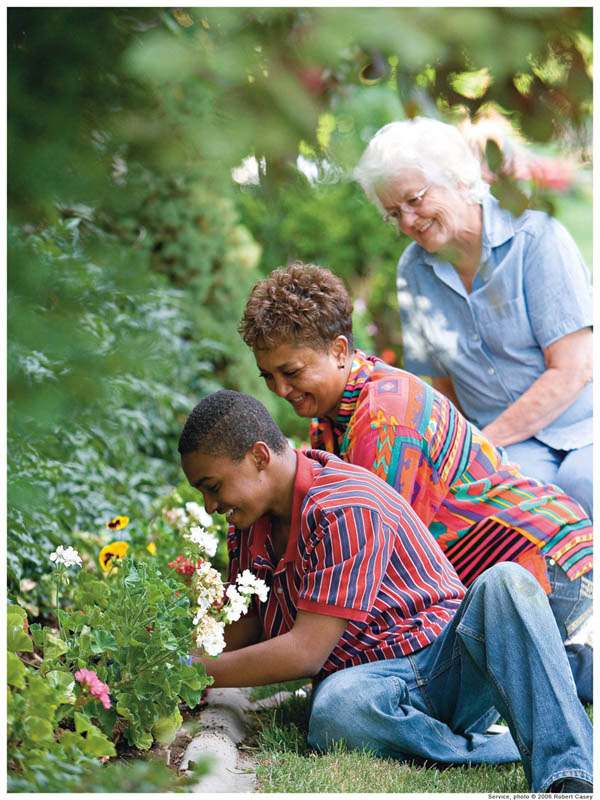Many people have seen the popular “I’m a Mormon” campaign, which outlines the lives of ordinary and diverse members of The Church of Jesus Christ of Latter-day Saints. What you may not know, though, is that more than 120,000 of those profiles are of people with disabilities. Some are written by the members themselves. Others are unscripted videos. Recently, The American Association of People with Disabilities recognized the Church for its outstanding portrayal of people with disabilities in mass media. AAPD President and CEO Mark Perriello said, “They tell the disability experience in a way that is real, no apologies, and it’s absolutely astounding.” He called them a powerful force for changing public perceptions of people with disabilities.
One video includes the amusing story of a man with just one leg. Most of his young martial arts students don’t know that one of his legs is artificial so when a child yanked it off by mistake, the class—including the waiting mothers—were thrown into chaos of tears and screaming. This man, Tim Hurst is also a marathon runner.Ingrid Maldonado, a Guatemalan amputee, is a college student and also works for the government, helping people who can’t read or write with applications. She lost her legs a little at a time after catching on fire and had a series of surgeries from ages two to twelve. When she gets depressed, she remembers that others suffer far more and that Jesus Christ, though suffering great trials, went through life essentially happy and that she can, too. She considers herself a person with no limits.
Jarom Frye survived cancer as a teenager but lost a leg when he chose amputation over the other options. He is a serious athlete—he climbs rocks, water skis, snow skis, and rides a mountain bike. He couldn’t find just the leg he needed…so he built his own. Today he creates products to help other people with disabilities to carry out their own dreams. He decided as a teenager to ignore the experts who told him he couldn’t continue his athletic life and he has proven them all wrong. He is a husband, a father, an innovator, and of course, a Mormon.
The Mormons have a wide range of resources for people with disabilities. Children with special needs are integrated into their regular classrooms at church, both for their own advantage and for the benefit of their classmates. Materials for church members are available in braille, audio, captioned video, American Sign Language and large print. A website about disabilities for members with special needs, parents, teachers, and leaders is available in ten languages. Buildings are accessible to those who need accessibility. When a child has a special need, the teachers and leaders are taught how to meet those needs and when necessary, an aid is provided. The humanitarian services program offers a wheelchair program and a vision program for people who are not Mormon in many countries.
When visiting a Mormon ward (congregation), you might find a sign language interpreter in the worship service, an aid for an autistic child in the Primary children’s organization, a blind toddler nursery leader, or a boy in a wheelchair passing the sacrament (communion). Most Mormons have volunteer positions referred to as callings, and people with disabilities serve in most of those positions, including leadership positions. Sometimes leaders become very creative in finding meaningful work for someone who has intense special needs. One congregation appointed a young adult with an intellectual disability to ring the bells each week signifying the end of class—a calling that required her to learn to tell time first. Another built a special tool to help a teenage boy pass the sacrament effectively.
In one congregation, a teenager with autism was unable to earn her Personal Progress award, which required a challenging series of accomplishments. The girl’s church classmates decided to earn it for her. Each girl completed one part of her award in addition to doing that part for herself. When they had all finished, she received her award as a gift from the other teenagers.
A thirteen-year-old boy named Spencer, featured in the video below, was chosen as the youth leader for his church class. He was given a responsibility to look after the needs of all the other boys in his class. One boy was named Dayton. Dayton has cerebral palsy and can only communicate through blinking. Spencer is an athlete who runs triathlons and he wanted to give Dayton opportunities he might never have. He asked Dayton if he’d like to enter a triathlon with Spencer and Dayton did. It took some planning, but they figured out how to do it. Spencer swam and biked pulling Dayton behind him in a boat and cart and then on a specially made bike. Spencer was exhausted, but finished the race happily. Each boy also passes the sacrament with Dayton so he can do what the other boys do—they push his chair while carrying the sacrament on a tray on his chair. This is the sort of training young Mormons receive in their church classes by caring association with those who have special needs and this impacts how they will interact the rest of their lives.

